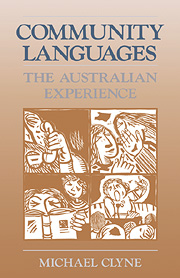Book contents
- Frontmatter
- Contents
- List of tables
- List of graphs
- Map of Australia
- Preface
- 1 Australia between monolingualism and multilingualism
- 2 Distribution and maintenance of community languages in Australia
- 3 The use of community languages in Australia
- 4 Structural and typological aspects of community languages
- 5 The formulation and implementation of language policies
- Appendix
- Glossary
- Bibliography
- Index
4 - Structural and typological aspects of community languages
Published online by Cambridge University Press: 09 November 2009
- Frontmatter
- Contents
- List of tables
- List of graphs
- Map of Australia
- Preface
- 1 Australia between monolingualism and multilingualism
- 2 Distribution and maintenance of community languages in Australia
- 3 The use of community languages in Australia
- 4 Structural and typological aspects of community languages
- 5 The formulation and implementation of language policies
- Appendix
- Glossary
- Bibliography
- Index
Summary
INTRODUCTION
This chapter deals with the formal aspect of the community languages that are being used, maintained and rejected in Australia. I shall discuss how limited use of and exposure to community languages as well as English influence have led to changes in the way in which speakers of the languages in Australia use them. I shall also address interlingual code-switching and its causes, and attempt to assess the possible implications for linguistic theory of Australian language contact phenomena (notably syntactic change and code-switching). Non-linguists may prefer to disregard the sections on grammatical change and code switching, pp. 176–84 and 191–207
As early as 1950, Haugen pointed to the theoretical gains that could be derived from studying languages of different typologies all in contact with the same language (English). Australia is an outstanding linguistic laboratory for this. However, of the approximately 100 community languages spoken in Australia today, hardly a dozen have so far been subjected to detailed linguistic analysis, and almost all of these are Germanic, Romance or Slavic languages.
THE DATA
The main corpus base in this chapter is that examined for my studies of German and Dutch in Australia — drawn from tapes of the following: 200 German-speaking postwar migrants and their children and 200 Dutch-speaking postwar migrants and their children (Clyne 1967, 1977a); 50 German-speaking pre-war refugees (Clyne 1973); 70 Australian-born children of pre- and postwar German-speaking emigrants; and 340 descendants of German pioneer settlers in rural areas of South Australia, Victoria, and southern New South Wales (Clyne 1968a, b).
- Type
- Chapter
- Information
- Community LanguagesThe Australian Experience, pp. 157 - 212Publisher: Cambridge University PressPrint publication year: 1991
- 1
- Cited by

